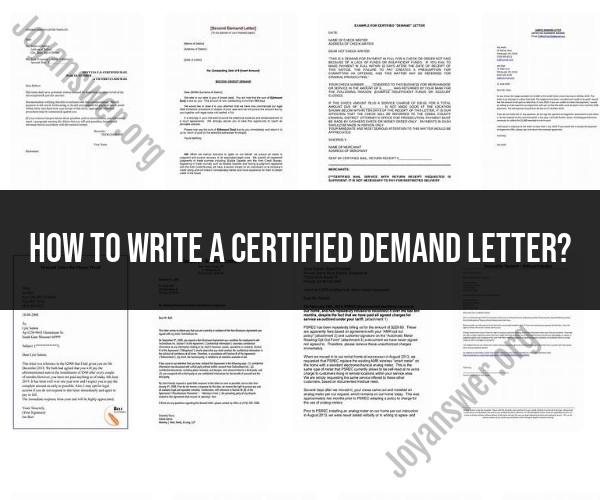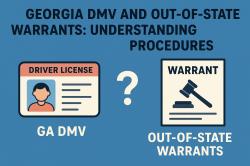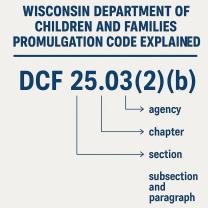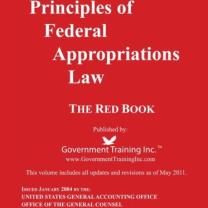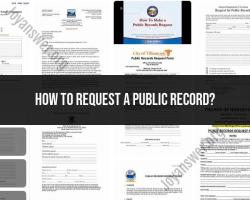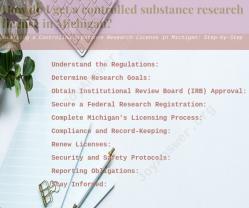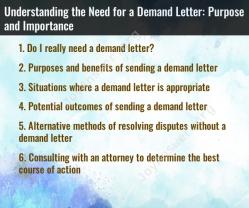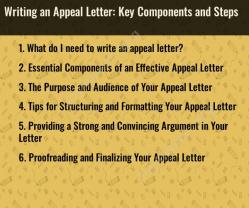How to write a certified demand letter?
A certified demand letter is a formal document sent to a person or entity to formally request a specific action or remedy a situation. This type of letter is often used in legal matters and should be well-structured and professional. Here's a comprehensive guide on how to write a certified demand letter:
1. Use Proper Formatting:
- Begin with your contact information at the top, followed by the date. Skip a line, and then include the recipient's name and address.
2. Add a Subject Line:
- A brief subject line should clearly state the purpose of the letter, e.g., "Demand for Payment" or "Notice of Breach."
3. Salutation:
- Address the recipient formally, using their full name and title, if known. For example, "Mr. John Smith" or "ABC Company, Inc."
4. Introduction:
- Start the letter with a brief and professional introduction. State your name and the reason for writing the letter. Be concise and to the point.
5. Background and Details:
- Provide a detailed account of the situation or issue. Include any relevant facts, dates, and supporting documents to make your case clear. This section should explain why you are making the demand.
6. Demand for Action:
- Clearly state the specific action you are demanding from the recipient. Whether it's payment, performance of a contract, or any other remedy, be explicit in your request.
7. Legal Grounds (if applicable):
- If your demand is based on legal rights or obligations, cite the relevant laws, contracts, or agreements that support your position. Explain why the recipient is legally obligated to meet your demand.
8. Set a Deadline:
- Specify a reasonable deadline for the recipient to respond or take the requested action. This allows them time to rectify the situation and shows that you are acting in good faith.
9. Consequences of Non-Compliance:
- Make it clear that you will take further legal action if the recipient does not comply with your demand within the specified timeframe. Mention any legal rights or remedies you may pursue.
10. Signature:
- Sign the letter in ink. If applicable, you can also include the names and contact information of any legal representatives or attorneys involved in the matter.
11. Certified Mail:
- Optionally, send the letter via certified mail with a return receipt requested. This provides evidence that the recipient received the letter. Keep the mailing receipt and the return receipt for your records.
12. Keep Copies:
- Make copies of the demand letter for your own records. It's essential to have documentation of the correspondence.
13. Professional Tone:
- Maintain a professional, respectful, and unemotional tone throughout the letter. Avoid using threatening or offensive language.
14. Proofread:
- Carefully proofread the letter to ensure it is free of spelling and grammatical errors. A well-written letter conveys professionalism and seriousness.
15. Follow Up:
- After sending the certified demand letter, allow the recipient the specified time to respond. Be prepared to take further action if necessary.
Remember that a certified demand letter should be taken seriously, and it is often a prelude to potential legal action. If you are unsure about the legal aspects of your situation, consider consulting an attorney to ensure that your letter is legally sound and effective.
Writing a Certified Demand Letter: A Comprehensive Guide
Certified demand letters are a formal way to communicate your demands to another party in writing. They are often used in legal matters, such as debt collection, contract disputes, and personal injury cases.
To write a certified demand letter, follow these steps:
- Start with a clear and concise introduction. State your name and contact information, as well as the name and contact information of the person or entity you are sending the letter to.
- Identify the purpose of the letter. State the reason you are writing and what you are demanding. Be as specific as possible.
- Provide supporting evidence. If you have any evidence to support your claims, such as contracts, invoices, or medical records, include it with your letter.
- Set a deadline. Give the recipient a reasonable amount of time to respond to your demands.
- State the consequences of noncompliance. Explain what will happen if the recipient does not meet your demands by the deadline.
- Close the letter professionally. Thank the recipient for their time and consideration.
The Purpose and Legal Significance of Demand Letters
Certified demand letters serve two main purposes:
- To communicate your demands to the other party in writing.
- To establish a written record of your communication in case the matter proceeds to court.
Demand letters can also have legal significance. In some cases, a demand letter may be required before you can file a lawsuit. Additionally, if the recipient of your demand letter agrees to meet your demands, you can create a binding contract by putting the agreement in writing.
Key Components and Structure of a Certified Demand Letter
A certified demand letter should include the following key components:
- Introduction: State your name and contact information, as well as the name and contact information of the person or entity you are sending the letter to.
- Body: Identify the purpose of the letter, provide supporting evidence, set a deadline, and state the consequences of noncompliance.
- Conclusion: Thank the recipient for their time and consideration.
The structure of a certified demand letter should be clear and concise. Use short paragraphs and bullet points to make your points easy to understand. Avoid using legal jargon or technical language.
Tips for Effective Communication in Your Demand Letter
When writing a certified demand letter, it is important to be clear, concise, and professional. Here are some tips for effective communication:
- Be specific about your demands.
- State the facts of the case in a logical order.
- Provide supporting evidence to support your claims.
- Use clear and concise language.
- Avoid using legal jargon or technical language.
- Be respectful of the recipient, even if you are angry or upset.
- Proofread your letter carefully before sending it.
Ensuring Clarity and Professionalism in Your Legal Communication
Clarity and professionalism are essential in all legal communication, including demand letters. To ensure that your demand letter is clear and professional, follow these tips:
- Use plain language that is easy to understand.
- Avoid using legal jargon or technical language.
- Proofread your letter carefully before sending it.
- Have someone else proofread your letter, if possible.
- Get legal advice from an attorney if you are unsure about anything.
By following these tips, you can write a certified demand letter that is clear, concise, professional, and legally effective.
